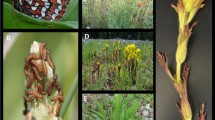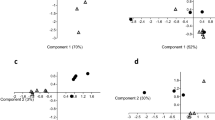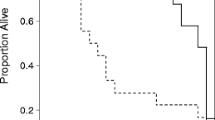Abstract
Larvae of the buckeye,Junonia coenia (Nymphalidae) feed primarily on plants in four families: Scrophulariaceae, Plantaginaceae, Verbenaceae, and Acanthaceae. These plant families have in common the presence of a group of plant secondary compounds, the iridoid glycosides. Larvae were reared on three plant species and two artificial diets, one with and one without iridoid glycosides.Larvae grew poorly and had low survivorship on the artificial diet without iridoid glycosides, while growth and survival on the artificial diet with iridoid glycosides was comparable to that on plants. Choice tests using artificial diets with and without iridoid glycosides showed that larvae: (1) chose diets with iridoid glycosides (in the form of a crude extract or pure compound) over a diet without; (2) showed no preference between the diet with the crude extract and that with pure iridoid glycoside, and (3) preferred the artificial diet with ground leaves of the host plant,Plantago lanceolata, over the diet with pure iridoid glycosides. The artificial diet that larvae had been reared on prior to these tests had no effect on subsequent larval preferences in the choice tests.
Similar content being viewed by others
References
Berenbaum, M. 1981. Effects of linear furanocoumarins on an adapted specialist insect (Papilio polyxenes)Ecol. Entomol. 6:345–351.
Berenbaum, M. 1983. Coumarins and caterpillars: A case for coevolution.Evolution 37:163–179.
Bernays, E., andDeLuca, C. 1981. Insect anti-feedant properties of an iridoid glycoside: Ipolamiide.Experientia 37:1289–1290.
Blum, M.S. 1983. Detoxication, deactivation and utilization of plant compounds by insects, pp. 265–275.in P.A. Hedin (ed.). Plant Resistance to Insects. American Chemical Society Symposium Series 208. American Chemical Society, Washington, D.C.
Bordner, J., Danehower, D., Thacker, J.D., Kennedy, G.G., Stinner, R.E., andWilson, K.G. 1983. Chemical basis for host-plant selection, pp. 245–264,in P.A. Hedin (ed.). Plant Resistance to Insects. American Chemical Society Symposium Series 208. American Chemical Society, Washington D.C.
Bowers, M.D. 1981. Unpalatability as a defense strategy of western checkerspot butterflies (Euphydryas Scudder, Nymphalidae).Evolution 34:586–600.
Bowers, M.D. 1983. The role of iridoid glycosides in host-plant specificity of checkerspot butterflies.J. Chem. Ecol. 9:475–493.
Burnett, W.C., Jones, S.B., Mabry, T.J., andPadolina, W.G. 1974. Sesquiterpene lactonesinsect feeding deterrents inVernonia.Biochem. Syst. Ecol. 2:25–29.
Duff, R.B., Bacon, J.S.D., Mundie, C.M., Farmer, V.C., Russell, J.D., andForrester, A.R. 1965. Catalpol and methylcatalpol: Naturally occurring glycosides inPlantago andBuddleia species.Biochem. J. 96:1–5.
Emmel, T.C., andEmmel, J.F., 1973. The Butterflies of Southern California. Natural History Museum of Los Angeles County, Los Angeles.
Harris, L. 1972. The Butterflies of Georgia. University of Oklahoma Press, Norman. Oklahoma.
Harvey, D.J. 1984. Observations on the biology and systematics of the species ofJunonia butterflies (Lepidoptera: Nymphalidae) in Florida and the Bahamas.J. Res. Lep., in press.
Howe, W.H. 1975. The Butterflies of North America. Doubleday, New York.
Jensen, S.R., Nielsen, B.J.; andDahlgren, R. 1975. Iridoid compounds, their occurrence and systematic importance in the angiosperms.Bot Not. 128:148–180.
Jermy, T., Hanson, F.E., andDethier, V.G. 1968. Induction of specific foodplant preference in lepidoptrous larvae.Entomol. Exp. Appl. 11:211–230.
Jirawongse, V. 1964. A chemotaxonomic study of the Scrophulariaceae. PhD. thesis. Purdue University, University Microfilms, Inc.
Klots, A.B. 1958. A Field Guide to the Butterflies. Houghton Mifflin, Boston.
Kooiman, P. 1970. The occurrence of iridoid glycosides in the Scrophulariaceae.Acta Bot Neerl. 19:329–340.
Lenczweski, B. 1980. Butterflies of Everglades National Park. South Florida Research Center Report T-588. 110 pp.
Lincoln, D.E., Newton, T.S., Ehrlich, P.R., andWilliams, K.S. 1982. Coevolution of the checkerspot butterflyEuphydryas chalcedona and its larval food plantDiplacus aurantiacus: Larval response to protein and leaf resin.Oecologia 52:216–223.
Munroe, E.G. 1951. The genusJunonia in the West indies (Lepidoptera, Nymphaiidae).Am. Mus.Novit. 1498:1 16.
Munz, P.A. 1968. A California Flora and Supplement. University of California Press, Berkeley.
Neck, R.W. 1976. Lepidopteran foodplant records from Texas.J. Res. Lepid. 15:75–82.
Rodman, J.E., andChew, F.S. 1980. Phytochemical correlates of herbivory in a community of native and naturalized Cruciferae.Biochem. Syst. Ecol. 8:43–50.
Schoonhoven, L.M. 1972. Secondary plant substances and insects, pp. 197–224,in V.C. Runeckles and T.C. Tso (eds.). Recent Advances in Phytochemistry, Vol. 5. Academic Press, New York.
Scott, J.A. 1972. Comparative mating and dispersal systems in butterflies. PhD thesis. University of California, Berkeley.
Scott, J.A. 1975. Movement ofPrecis coenia, a “pseudoterritorial” submigrant (Lepidoptera: Nymphaiidae).J. Anim. Ecol. 44:843–850.
Scudder, S.H. 1879.Junonia coenia in New England.Psyche 2:276–277.
Scudder, S.H. 1889. The Butterflies of the Eastern United States with Special Reference to New England, published by the author. Cambridge, Massachusetts.
Shapiro, A.M. 1974a. The butterfly fauna of the Sacramento Valley, California.J. Res. Lepid. 13:115–122.
Shapiro, A.M. 1974b. Butterflies of the Suisun Marsh, California.J. Res. Lepid. 13:191–206.
Shields, O. 1966. Reference in North American Annual Summary for 1965, Zone I. News of the Lepidopterists' Society Vol. 3, p.4.
Sokal, R.R., andRohlf, F.J. 1969. Biometry. Freeman, San Francisco.
Tietz, H.M. 1952. The Lepidoptera of Pennsylvania. Pennsylvania State College, School of Agriculture, State College, Pennsylvania.
Tietz, H.M. 1972. An Index to the Life Histories of the North American Macrolepidoptera. Allyn Museum of Entomology, Sarasota, Florida.
Tilden, J.W. 1970. Comments on the nearctic members of the genusPrecis Huebner.J. Res. Lepid. 9:101–108.
Trim, A.R., andHill, R. 1952. The preparation and properties of aucubin, asperuloside and some related glycosides.Biochem. J. 50:310–319.
Turner, T.W., andParnell, J.R. 1983. The identification of two speciesof Junonia Hubner (Nymphaiidae),J. evarete andJ. genoveva, in Jamaica with the establishment of neotypes for both species. Abstract, 1983 meeting of Lepidopterists' Society, Columbus, Ohio.
Weiffering, J.H. 1966. Aucubinartige Glucoside (Pseudoindikane) und verwandte Heteroside als systematicshe Merkmale.Phytochemistry 5:1053–1064.
Author information
Authors and Affiliations
Rights and permissions
About this article
Cite this article
Bowers, M.D. Iridoid glycosides and host-plant specificity in larvae of the buckeye butterfly,Junonia coenia (Nymphalidae). J Chem Ecol 10, 1567–1577 (1984). https://doi.org/10.1007/BF00988425
Received:
Revised:
Issue Date:
DOI: https://doi.org/10.1007/BF00988425




